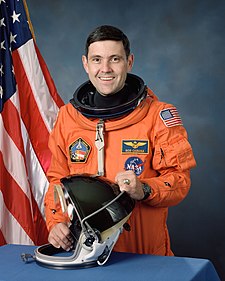Robert Cabana
| Robert Donald Cabana | |
|---|---|
 Robert Donald Cabana | |
| Astronaut NASA | |
| Státní příslušnost | |
| Datum narození | 23. ledna 1949 (73 let) |
| Místo narození | Minneapolis, Minnesota |
| Hodnost | Plukovník, Námořní pěchota |
| Čas ve vesmíru | 37 dní, 22 hodin a 42 minut |
| Kosmonaut od | 1985 |
| Mise | STS-41, STS-53, STS-65, STS-88 |
| Znaky misí | |
| Některá data mohou pocházet z datové položky. | |
Robert Donald Cabana (* 23. ledna 1949 v Minneapolisu, stát Minnesota, USA), americký kosmonaut, důstojník, ředitel kosmodromu. Ve vesmíru byl čtyřikrát.
Život
Mládí a výcvik
V roce 1967 absolvoval střední školu ve Washburnu, poté v letech 1967–1971 námořní akademii (US Naval Academy) v Annapolis (obor matematika). V týmu astronautů NASA byl v letech 1985 až 2004. Oženil se s Nancy, rozenou Shimerovou a mají spolu tři děti.
Lety do vesmíru
Na oběžnou dráhu se v raketoplánech dostal čtyřikrát a strávil ve vesmíru 37 dní, 22 hodiny a 42 minut. Byl 230 člověkem ve vesmíru.
- STS-41 Discovery (6. října 1990 – 10. října 1990), pilot
- STS-53 Discovery (2. prosince 1992 – 9. prosince), pilot
- STS-65 Columbia (8. července 1994 – 23. července 1994), velitel
- STS-88 Endeavour (4. prosince 1998 – 13. prosince 1998), velitel
Odkazy
Externí odkazy
 Obrázky, zvuky či videa k tématu Robert Cabana na Wikimedia Commons
Obrázky, zvuky či videa k tématu Robert Cabana na Wikimedia Commons - Cabana na webu SPACE
- Cabana na webu MEK
Média použitá na této stránce
STS-41 Mission Insignia
Designed by the crew members, this patch commemorates the first assembly flight to carry United States-built hardware for constructing the International Space Station (ISS). This flight's primary task is to assemble the cornerstone of the Space Station: the Node with the Functional Cargo Block (fgb). The rising sun symbolizes the dawning of a new era of international cooperation in space and the beginning of a new program: the International Space Station. The Earth scene outlines the countries of the Station Partners: the United States, Russia, those of the European Space Agency (ESA), Japan, and Canada. Along with the Pressurized Mating Adapters (PMA) and the Functional Cargo Block, the Node is shown in the final mated configuration while berthed to the Space Shuttle during the STS-88/2A mission. The Big Dipper Constellation points the way to the North Star, a guiding light for pioneers and explorers for generations. In the words of the crew, "These stars symbolize the efforts of everyone, including all the countries involved in the design and construction of the International Space Station, guiding us into the future."
Emblem of Nasa's STS-53 mission
- Designed by the crewmembers, the STS-53 insignia shows the Space Shuttle Discovery rising to new achievements as it trails the symbol of the Astronaut Office against a backdrop of the American flag. The five stars and three stripes also serve to symbolize the mission designation (STS-53) and America's continuing commitment to world leadership in space. The pentagonal shape of the patch represents the Department of Defense (DOD) and its support of the Space Shuttle Program. The band delineating the flag from space includes the four colors of the military services of the crewmembers. The names of the flight crewmembers are located along the border of the patch. They are Commander David M. Walker, Pilot Robert D. Cabana, Mission Specialist (MS) Guion S. Bluford, MS James S. Voss, and MS Michael R. U. Clifford. Each crewmember contributed to the design of the insignia.
STS-65 Mission Insignia
Robert D. Cabana, STS-88 mission commander





